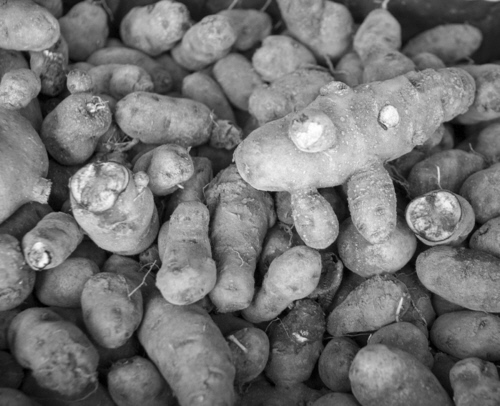We went to the small village of Scano Montiferro, which is situated in the mountains south of Bosa, in order to meet Salvatore Murtas and get to know his potatoes called “patata ‘e moru”. Salvatore, a man in his eighties and very open, lives with his wife in their self-built house. Upon our arrival, we were immediately invited inside where Salvatore started telling us about his life.
Listening to him talking felt like experiencing his story, talking about his childhood when he and his brother Francesco were cultivating the patata ‘e moru (potato brought from the Moors) together with their father who was a peasant. In fact, this ancient tuber was imported from South America at least 100 years ago and it is still being cultivated in Peru and Bolivia. It’s a strangely shaped tuber, it’s violet inside, it has a low yield, but it’s rich in antioxidants, really the same substances which may prevent cancer,also occurring in blueberries and in general in blue-violet vegetables. These potatoes are good for making potato dumplings, ravioli, but above all baked potatoes because the skin is very thin. You just clean them and put them in the oven, according to Salvatore. In spite of the many virtues of this violet potato, it is unfortunately more or less unknown in the rest of Sardinia, probably because of the low yield.
During the hard times of the 1950s Salvatore emigrated to Venezuela in order to find work, staying for 8 years, working on oil rigs in order to extract oil below the Atlantic ocean. Then, he moved to Switzerland where he worked in a foundry, sometimes returning to Scano Montiferro. There, he met his future wife Maria, and after some years living together in Switzerland and 16 years in total abroad, Salvatore decided to go back to where he came from and start redoing what he was doing together with his father and brother in Scano Montiferro many years ago. Upon returning in 1971 he started cultivating his lands with seeds, which have been passed through the generations, keeping an ancient tradition of the village at the same time. He asked one of the locals who was cultivating the violet potato for some seed potatoes and he has been cultivating them ever since. He has to wait for the correct moment to plant them, usually in March, while he harvests new potatoes in August. Salvatore also said that not all soils are apt for cultivation of the violet potato, and he prefers soft soil in the mountains, while hard soil is to be avoided.
It means a lot to Salvatore to maintain traditions and in addition to violet potatoes he also cultivates ancient grapevines called Pascale Nieddu and Pascale Biancu, grapevines which noone else cultivates and for this reason he considers himself a custodian of ancient treasures of the earth.
Fortunately, the local agency called LAORE, which occupies itself with rural development, organises courses both in Scano Montiferro and in all of Sardinia. This has led a group of young people, who have participated in some of these courses, to start an agricultural cooperative with the intention of continuing the work of Salvatore. He has given them seeds and now they are also cultivating violet potatoes and the grapevines Pascale Nieddu and Pascale Biancu. Besides, they are also grafting fruit trees like pear and apple trees. I really hope that he will go on spreading seeds to other agriculturalists all across Sardinia.
Salvatore also showed us his wine cellar, but which looked more like an artist’s workshop since he works as an artist in winter spending his days in his workshop where he creates sculptures of cork, like models of nuraghes, toys, kitchen utensils and other objects in common usage, everything done manually with his tools.
When we were about to leave, his wife Maria showed us a selection of beans and other legumes all of which are preserved for sowing later, but also garlic, onions, tomatoes, Sardinian potatoes with red skin, that is all of them genuine products of their lands. We were also shown very rustic and rather unevenly shaped tomatoes, common tomatoes which are sun-dried, then put in glass jars together with brine and stored in a dark and cool place. They also had a cheese called Casizolu, where the curd is stretched and kneaded in hot water, developing a stringy, fibrous body. It is shaped like a pear and it is made by using milk from cows of the race Modicana Sarda.
It was a real pleasure to spend a sunny morning with this family and enjoyable to get to know such open and kind persons like Salvatore and Maria.

